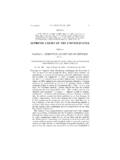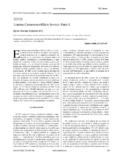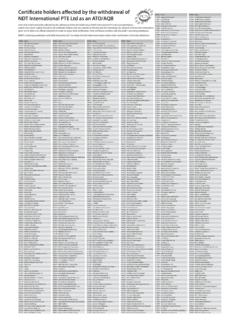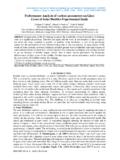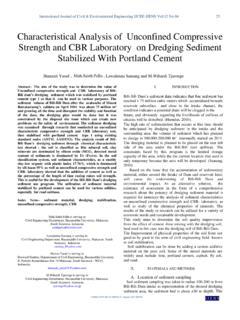Transcription of RESEARCH REPORT 285 - Health and Safety Executive
1 HSE Health & Safety Executive Protection of piping systems subject to fires and explosions Prepared by The Steel Construction Institute for the Health and Safety Executive 2005 RESEARCH REPORT 285 HSE Health & Safety Executive Protection of piping systems subject to fires and explosions Fadi hamdan The Steel Construction Institute Silwood Park Buckhurst Road Ascot SL5 7QN This document aims to fill this gap by providing guidance on the protection and response of piping systems and piping supports subject to fires and explosions. The guidance covers the methods used to carry out both simplified design checks and advanced non linear analysis.
2 It forms the background document to the FABIG Technical Note, to be published, on the protection of topside piping and piping supports against fires and explosions. This REPORT and the work it describes were funded by the Health and Safety Executive (HSE). Its contents, including any opinions and/or conclusions expressed, are those of the authors alone and do not necessarily reflect HSE policy. HSE BOOKS Crown copyright 2005 First published 2005 ISBN 0 7176 2920 1 All rights reserved. No part of this publication may be reproduced, stored in a retrieval system, or transmitted in any form or by any means (electronic, mechanical, photocopying, recording or otherwise) without the prior written permission of the copyright owner.
3 Applications for reproduction should be made in writing to: Licensing Division, Her Majesty's Stationery Office, St Clements House, 2-16 Colegate, Norwich NR3 1BQ or by e-mail to ii FOREWORD This work was prepared to fill gaps in existing knowledge on response of piping systems to hydrocarbon fires and explosions. iii iv CONTENTS FOREWORD III CONTENTS V Executive SUMMARY VII 1 INTRODUCTION 1 SCOPE OF THIS DOCUMENT 1 2 DESIGN BASIS 3 INTRODUCTION 3 GOAL SETTING APPROACH 3 RISK ASSESSMENT 18 BLAST AND FIRE STRATEGY FOR PIPING 29 3 DESIGN OF PIPING AGAINST EXPLOSIONS 35 INTRODUCTION 35 INTERACTION OF PIPING WITH OTHER DESIGN
4 DISCIPLINES 35 LOADING COMPONENTS ACTING ON PIPING DUE TO EXPLOSIONS 42 TYPES OF PIPING AND MATERIAL PROPERTIES 53 RESPONSE OF PIPING TO BLAST LOADING 57 ACCEPTANCE CRITERIA 61 GUIDELINES FOR DUCTILE CONSTRUCTION 63 SPECIFIC FPSO ISSUES 64 4 DESIGN OF PIPING SYSTEMS AGAINST FIRES 69 INTRODUCTION 69 INTERACTION OF FIRES AND EXPLOSIONS 69 TYPES OF FIRES AND CORRESPONDING HEAT FLUXES 70 DERIVATION OF TEMPERATURE FROM HEAT FLUXES 72 PASSIVE AND ACTIVE PROTECTION SYSTEMS 72 TYPES OF PIPING AND MATERIAL PROPERTIES 82 DESIGN OF PIPING UNDER FIRE 85 OUTSTANDING ISSUES 89 5 RESPONSE OF PIPE SUPPORTS TO FIRES AND EXPLOSIONS 91 INTRODUCTION 91 TYPE OF PIPING SUPPORTS 91 DESIGN OF PIPING SUPPORTS TO RESIST FIRES 98 DESIGN OF PIPING SUPPORT TO RESIST EXPLOSIONS 100 OUTSTANDING ISSUES 101 REFERENCES 103 v vi Executive SUMMARY The principles of design of primary structure to resist loading due to fire and blast have been extensively described in recent
5 Literature including the Interim Guidance Notes and subsequent FABIG Technical Notes. In offshore structures, many of the principles applicable to the design of primary structure are also applicable to piping systems and piping supports. However, the subdivision of discipline design expertise in many cases results in poor transfer of the design technology from primary structural design to other disciplines. This document aims to fill this gap by providing guidance on the protection and response of piping systems and piping supports subject to fires and explosions.
6 The guidance covers the methods used to carry out both simplified design checks and advanced non linear analysis. It forms the background document to the FABIG Technical Note, to be published, on the protection of topside piping and piping supports against fires and explosions. The original RESEARCH , on which this document is based, was sponsored by the Health and Safety Executive and was carried out by The Steel Construction Institute. vii viii 1 INTRODUCTION SCOPE OF THIS DOCUMENT This document gives guidance on the protection of topside piping and piping supports against hydrocarbon fires and explosions.
7 In Chapter Two, the design basis for the protection of piping systems and piping supports against fires and explosions is presented. Chapter Three provides more detailed guidance on calculating the blast load acting on piping systems and on determining the response of piping systems under explosion loading. Chapter Four provides similar guidance for fire scenarios and the ensuing structural response. Chapter Five presents guidance for the protection of piping supports against fires and explosions. This document considers almost exclusively hydrocarbon fuel sources originating within hazardous modules.
8 While it is primarily aimed at offshore modules, many of the recommendations are equally applicable to offshore oil and gas plants. This document draws on the reports from: Phase I Blast and fire Engineering Project for Topside Structures [1], Interim Guidance Notes [2] Phase II REPORT [3], CMR Explosion Handbook [4], Design of Offshore Facilities to Resist Gas and Explosion Hazard [5], Explosion Loading on Topsides Equipment, Part 1 OTO 1999 046 [6] FABIG Technical Note 6 High Strain rate and elevated temperature data [7] Review of the response of process vessel and equipment to fire attack [8]
9 Guideline for the Protection of Pressurised Systems Exposed to Fire [9 These projects identified numerous critical gaps in our knowledge and understanding. This document is, therefore, by definition, interim and will become outdated and require updating as these gaps continue to be closed by the industry. As much as possible, this document follows the same organisational layout as the IGN [2] and should be complemented by their use. 1 2 2 DESIGN BASIS INTRODUCTION This Chapter describes the hazard design philosophy for offshore platforms, and the corresponding Safety management systems and performance measures.]
10 It also describes how this philosophy is applied throughout the life cycle of the platform using inherently safe design procedures. Issues pertaining to existing installation are highlighted. The procedures used for deciding when the risk becomes tolerable are described, and control and mitigation measures for the remaining risk are discussed. GOAL SETTING APPROACH It is useful to place the blast and fire strategy for piping within the broader context of the fire and blast hazard management plan for the platform, and in turn, to place that within the overall hazard managements system and to relate that to the goal setting approach used by the offshore industry.










